Usability Testing
Practical Guides for Librarians
 About the Series
About the Series
This innovative series written and edited for librarians by librarians provides authoritative, practical information and guidance on a wide spectrum of library processes and operations.
Books in the series are focused, describing practical and innovative solutions to a problem facing todays librarian and delivering step-by-step guidance for planning, creating, implementing, managing, and evaluating a wide range of services and programs.
The books are aimed at beginning and intermediate librarians needing basic instruction/guidance in a specific subject and at experienced librarians who need to gain knowledge in a new area or guidance in implementing a new program/service.
 About the Series Editor
About the Series Editor
The Practical Guides for Librarians series was conceived by and is edited by M. Sandra Wood, MLS, MBA, AHIP, FMLA, Librarian Emerita, Penn State University Libraries.
M. Sandra Wood was a librarian at the George T. Harrell Library, The Milton S. Hershey Medical Center, College of Medicine, Pennsylvania State University, Hershey, PA, for over 35 years, specializing in reference, educational, and database services. Ms. Wood worked for several years as a Development Editor for Neal-Schuman Publishers.
Ms. Wood received a MLS from Indiana University and a MBA from the University of Maryland. She is a Fellow of the Medical Library Association and served as a member of MLAs Board of Directors from 1991 to 1995. Ms. Wood is founding and current editor of Medical Reference Services Quarterly , now in its 35th volume. She also was founding editor of the Journal of Consumer Health on the Internet and the Journal of Electronic Resources in Medical Libraries and served as editor/co-editor of both journals through 2011.
Titles in the Series
- How to Teach: A Practical Guide for Librarians by Beverley E. Crane
- Implementing an Inclusive Staffing Model for Todays Reference Services by Julia K. Nims, Paula Storm, and Robert Stevens
- Managing Digital Audiovisual Resources: A Practical Guide for Librarians by Matthew C. Mariner
- Outsourcing Technology: A Practical Guide for Librarians by Robin Hastings
- Making the Library Accessible for All: A Practical Guide for Librarians by Jane Vincent
- Discovering and Using Historical Geographical Resources on the Web: A Practical Guide for Librarians by Eva H. Dodsworth and L. W. Lalibert
- Digitization and Digital Archiving: A Practical Guide for Librarians by Elizabeth R. Leggett
- Makerspaces: A Practical Guide for Librarians by John J. Burke
- Implementing Web-Scale Discovery Services: A Practical Guide for Librarians by JoLinda Thompson
- Using iPhones and iPads: A Practical Guide for Librarians by Matthew Connolly and Tony Cosgrave
- Usability Testing: A Practical Guide for Librarians by Rebecca Blakiston
Usability Testing
A Practical Guide for Librarians
Rebecca Blakiston
Practical Guides for Librarians, No. 11
ROWMAN & LITTLEFIELD
Lanham Boulder New York London
Published by Rowman & Littlefield
A wholly owned subsidiary of The Rowman & Littlefield Publishing Group, Inc.
4501 Forbes Boulevard, Suite 200, Lanham, Maryland 20706
www.rowman.com
16 Carlisle Street, London W1D 3BT, United Kingdom
Copyright 2015 by Rowman & Littlefield
All rights reserved . No part of this book may be reproduced in any form or by any electronic or mechanical means, including information storage and retrieval systems, without written permission from the publisher, except by a reviewer who may quote passages in a review.
British Library Cataloguing in Publication Information Available
Library of Congress Cataloging-in-Publication Data
Blakiston, Rebecca, 1983
Usability testing : a practical guide for librarians / Rebecca Blakiston.
pages cm
Includes bibliographical references and index.
ISBN 978-1-4422-2899-3 (pbk. : alk. paper) ISBN 978-1-4422-2900-6 (ebook : alk. paper) 1. Library Web sitesDesign. 2. Library Web sitesTesting. 3. User-centered system design. 4. Web site development. I. Title.
Z674.75.W67B58 2015
006.701'9dc23 2014024454
 The paper used in this publication meets the minimum requirements of American National Standard for Information SciencesPermanence of Paper for Printed Library Materials, ANSI/NISO Z39.48-1992.
The paper used in this publication meets the minimum requirements of American National Standard for Information SciencesPermanence of Paper for Printed Library Materials, ANSI/NISO Z39.48-1992.
Printed in the United States of America
Contents
Preface
In our daily lives, we interact with a variety of websites, tools, products, and services in order to both complete tasks and find answers to our questions. The best experiences are usually effortless. The worst experiences are those that seem to take additional work or be complicated, or perhaps just seem broken altogether. How often do you get frustrated when trying to complete what should be a simple task? Perhaps you are trying to sign into your account on a website, download an app to your phone, or set your signature line within your e-mail. Or maybe your experience crosses into the physical environmentyou are trying to buy produce at a self-checkout machine in a grocery store, or locate a building in a large complex using a printed map. How exasperated do you get when you encounter challenges in trying to get things done or find what you are looking for?
Lets not cause these types of frustrations for library users. In Usability Testing: A Practical Guide for Librarians , you will learn how to discover usability problems with your library website by observing people actually trying to use it. Then perhaps most importantly, you will learn how to go about fixing those problems.
Ive known that usability is important for quite some time. In fact, I was assigned to read Steve Krugs best seller, Dont Make Me Think! A Common Sense Approach to Web Usability , in my library graduate program. Good user experience (UX) design actually has some close connections to librarianship: it relates to information-seeking behavior, information architecture, and discovery and findability of information.
In 2008, I was hired as a reference and instruction librarian. Surprisingly, I found myself encountering the issue of usabilityand lack of usabilitypretty directly on a daily basis. When you are helping people with their research, you quickly notice the usability of library websites, discovery tools, and databases. Even if you arent thinking about frustrations as usability problems, you are likely noticing what is working well and what isnt. You learn which tools you prefer to use because they are intuitive to use, have more useful features, and/or get you to the content you need more seamlessly. In my work providing research assistance, I often found myself advocating to improve the usefulness of the website and associated research databases.
My focus on improving the user experience didnt go unnoticed, and in 2010, I was assigned as our librarys first website product manager. With new title in hand, I was able to spearhead our UX efforts. But how? I had some very minimal knowledge of usability testing and knew that it was important, but had never thought to do it myself. The only experience our library had with usability testing in recent memory was a couple years earlier when an outside company conducted usability testing for us. They let us participate by watching from an observation room, and demonstrated why it was important, but it seemed like something that should really be left to the experts.
Next page
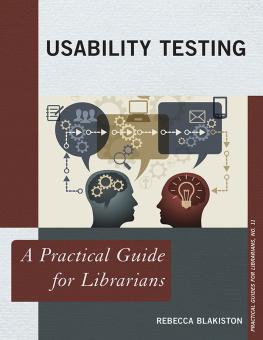
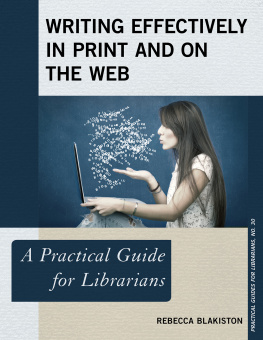
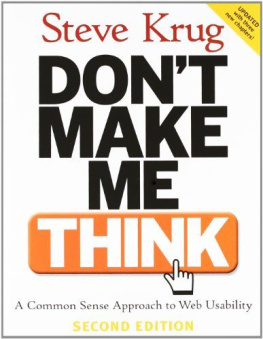
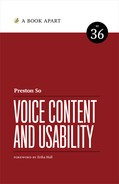

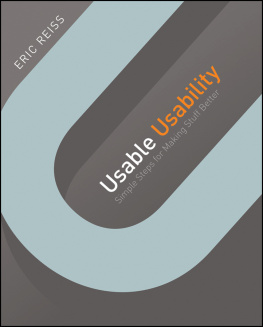
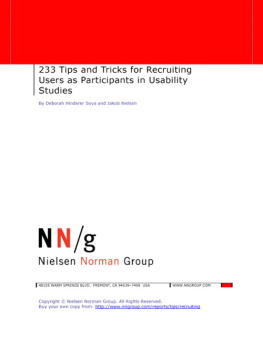
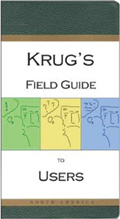
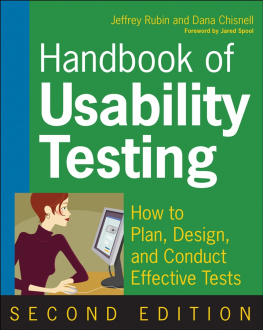
 About the Series
About the Series The paper used in this publication meets the minimum requirements of American National Standard for Information SciencesPermanence of Paper for Printed Library Materials, ANSI/NISO Z39.48-1992.
The paper used in this publication meets the minimum requirements of American National Standard for Information SciencesPermanence of Paper for Printed Library Materials, ANSI/NISO Z39.48-1992.